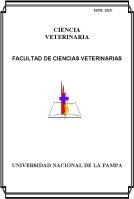Vater quality evolution in dairy farms of the province ofLa Pampa, Argentina
Keywords:
Water quality, Dairy farms, La PampaAbstract
The objective of this study was to determine the water quality evolution in dairy farms of the Province of La Pampa, Argentina. The hypothesis that mega-dairy farms, because of their high animal population (400-700 cows), could cause water salinisation, due to an excessive use of ground water, and ground water contamination, as a result of accumulation of waste, was posed. We decided to compare then with medium dairy farms (lOO to 250 cows) to evaluate the impact of both models on water quality. We worked with 8 dairy farms in each category. During 3 consecutive years, samples of water were obtained every 6 months. Chemical (pR, total Salinity, Rardness, Sulfates, Chloride, Nitrates, Nitrites, Ammoniac, Calcium, Magnesium, Fluorine and Arsenium) and bacteriological analyses were performed in each sample. A statistically significant increase of the water Total Salinity could not be demonstrated in neither of the two groups. Rowever, in a few dairy farms, evidence of salinisation was found. A number of coliform bacteria above the tolerated values for human consumption, and belonging to a certain percentage of samples, was found within the first sampling. After corrective procedures were carried out, the results were negative in the sucessive samplings, without evidence of fecal contamination. In both groups, an important percentage of samples with Total Salinity, Sulfates, Fluorine and Arsenium levels above the advisable limits for dairy cattle was found.Downloads
Downloads
Published
How to Cite
Issue
Section
License
Al momento de enviar sus contribuciones, los colaboradores deberán declarar , de manera fehaciente, que poseen el permiso del archivo o repositorio donde se obtuvieron los documentos que se anexan al trabajo, cualquiera sea su formato (manuscritos inéditos, imágenes, archivos audiovisuales, etc.), permiso que los autoriza a publicarlos y reproducirlos, liberando a la revista y sus editores de toda responsabilidad o reclamo de terceros , los autores deben adherir a la licencia Creative Commons denominada “Atribución - No Comercial CC BY-NC-SA”, mediante la cual el autor permite copiar, reproducir, distribuir, comunicar públicamente la obra y generar obras derivadas, siempre y cuando se cite y reconozca al autor original. No se permite, sin embargo, utilizar la obra con fines comerciales.




.jpg)

4.png)


7.png)



